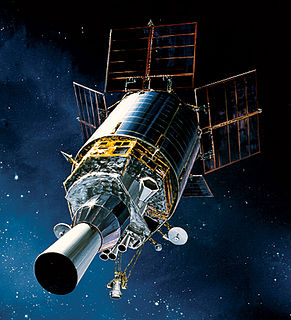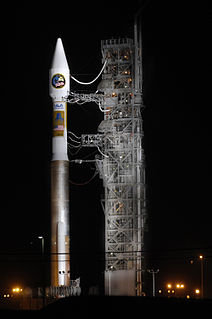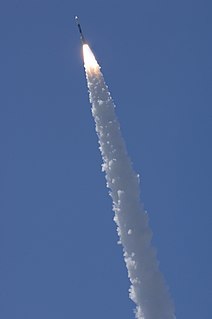
The Defense Support Program (DSP) is a program of the United States Space Force that operated the reconnaissance satellites which form the principal component of the Satellite Early Warning System used by the United States.

The Space-Based Infrared System (SBIRS) is a United States Space Force system intended to meet the United States' infrared space surveillance needs through the first two to three decades of the 21st century. The SBIRS program is designed to provide key capabilities in the areas of missile warning, missile defense and battlespace characterization via satellites in geosynchronous Earth orbit (GEO), sensors hosted on satellites in highly elliptical orbit (HEO), and ground-based data processing and control.
Lockheed Martin Space is one of the four major business divisions of Lockheed Martin. It has its headquarters in Denver, Colorado, with additional sites in Sunnyvale, California; Santa Cruz, California; Huntsville, Alabama; and elsewhere in the United States and United Kingdom. The division currently employs about 16,000 people, and its most notable products are commercial and military satellites, space probes, missile defense systems, NASA's Orion spacecraft, and the Space Shuttle external tank.

The Missile Defense Alarm System, or MIDAS, was a United States Air Force Air Defense Command system of 12 early-warning satellites that provided limited notice of Soviet intercontinental ballistic missile launches between 1960 and 1966. Originally intended to serve as a complete early-warning system working in conjunction with the Ballistic Missile Early Warning System, cost and reliability concerns limited the project to a research and development role. Three of the system's 12 launches ended in failure, and the remaining nine satellites provided crude infrared early-warning coverage of the Soviet Union until the project was replaced by the Defense Support Program. MiDAS represented one element of the United States's first generation of reconnaissance satellites that also included the Corona and SAMOS series. Though MIDAS failed in its primary role as a system of infrared early-warning satellites, it pioneered the technologies needed in successor systems.

USA-200, also known as NRO Launch 28 or NROL-28, is an American signals intelligence satellite, operated by the National Reconnaissance Office. Launched in 2008, it has been identified as the second satellite in a series known as Improved Trumpet, Advanced Trumpet, or Trumpet follow-on; a replacement for the earlier Trumpet series of satellites.
The Space Tracking and Surveillance System (STSS) was a pair of satellites developed by the United States Missile Defense Agency (MDA) to research the space-based detection and tracking of ballistic missiles. Data from STSS satellites could allow interceptors to engage incoming missiles earlier in flight than would be possible with other missile detection systems. The STSS program began in 2001, when the "SBIRS Low" program was transferred to MDA from the United States Air Force. In December 2002, SBIRS Low Research & Development was renamed Space Tracking and Surveillance System (STSS).
WorldView-4, previously known as GeoEye-2, was a third generation commercial Earth observation satellite launched on 11 November 2016, at 18:30:33 UTC. The spacecraft was operated by DigitalGlobe. With a maximum resolution of 31 cm (12 in), WorldView-4 provided similar imagery as WorldView-3, the highest resolution commercially available at the time of its launch.

USA-205, also known as Space Tracking and Surveillance System-Advanced Technology Risk Reduction (STSS-ATRR), and previously as Block 2010 Spacecraft Risk Reduction is a satellite formerly operated by the United States Missile Defense Agency. It was launched to demonstrate new technology for missile detection early warning systems (MDEWS). The technology demonstrated on STSS-ATRR was used in the development of the Space Tracking and Surveillance System (STSS) part of the Space-Based Infrared System (SBIRS).

The Joint Polar Satellite System (JPSS) is the latest generation of U.S. polar-orbiting, non-geosynchronous, environmental satellites. JPSS will provide the global environmental data used in numerical weather prediction models for forecasts, and scientific data used for climate monitoring. JPSS will aid in fulfilling the mission of the U.S. National Oceanic and Atmospheric Administration (NOAA), an agency of the Department of Commerce. Data and imagery obtained from the JPSS will increase timeliness and accuracy of public warnings and forecasts of climate and weather events, thus reducing the potential loss of human life and property and advancing the national economy. The JPSS is developed by the National Aeronautics and Space Administration (NASA) for the National Oceanic and Atmospheric Administration (NOAA), who is responsible for operation of JPSS. Three to five satellites are planned for the JPSS constellation of satellites. JPSS satellites will be flown, and the scientific data from JPSS will be processed, by the JPSS – Common Ground System (JPSS-CGS).
USA-230, also known as SBIRS GEO-1, is a United States military satellite and part of the Space-Based Infrared System.
USA-184, also known as NRO Launch 22 or NROL-22, is an American signals intelligence satellite, operated by the National Reconnaissance Office. Launched in 2006, it has been identified as the first in a new series of satellites which are replacing the earlier Trumpet spacecraft.
Kosmos 2479 is a Russian US-KMO missile early warning satellite which was launched in 2012 as part of the Russian Aerospace Defence Forces' Oko programme. The satellite is designed to identify missile launches using infrared telescopes. It was the last US-KMO geostationary satellite, to be launched, prior to the system being replaced by EKS.
Kosmos 2422 was a Russian US-K missile early warning satellite which was launched in 2006 as part of the Russian Space Forces' Oko programme. The satellite was designed to identify missile launches using optical telescopes and infrared sensors.
Kosmos 2388 was a Russian US-K missile early warning satellite which was launched in 2002 as part of the Russian Space Forces' Oko programme. The satellite was designed to identify missile launches using optical telescopes and infrared sensors.
Kosmos 2222 is a Russian US-K missile early warning satellite which was launched in 1992 as part of the Russian Space Forces' Oko programme. The satellite is designed to identify missile launches using optical telescopes and infrared sensors.
Kosmos 2097 is a Russian US-K missile early warning satellite which was launched in 1990 as part of the Russian Space Forces' Oko programme. The satellite is designed to identify missile launches using optical telescopes and infrared sensors.
Kosmos 2050 is a Soviet US-K missile early warning satellite which was launched in 1989 as part of the Soviet military's Oko programme. The satellite is designed to identify missile launches using optical telescopes and infrared sensors.
LEROS is a family of chemical rocket engines manufactured by Nammo at Westcott, Buckinghamshire, United Kingdom. LEROS engines have been used as primary apogee engines for telecommunications satellites such as the Lockheed Martin A2100 as well as deep space missions such as Juno.

USA-273, also known as SBIRS GEO-3, is a United States military satellite and part of the Space-Based Infrared System (SBIRS).

USA-282, also known as SBIRS GEO-4, is a United States military satellite and part of the Space-Based Infrared System.








